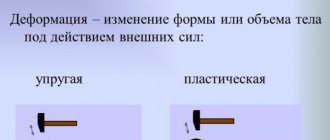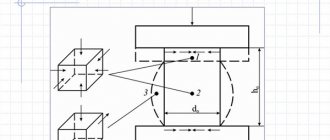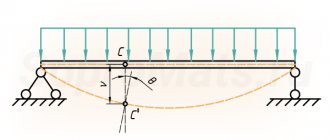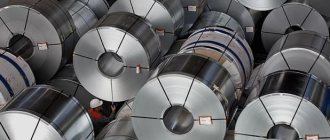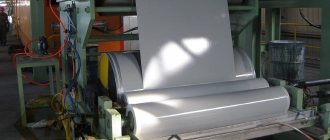Modulus of elasticity of steel
►Elasticity modulus of steel
►Elasticity modulus of different steel grades
►Table of strength moduli of steel grades
►Elastic modulus for metals and alloys
►Elasticity of steels
►Strength limit
When designing steel products or structural elements, the ability of the alloy to withstand multidirectional types of loads is taken into account: impact, bending, tensile, compressive. The value of the elastic modulus of steel, along with hardness and other characteristics, shows resistance to these influences.
For example, in reinforced concrete construction, longitudinal and transverse reinforcing bars are used. In the horizontal plane they are subject to tension, and in the vertical plane they are subject to pressure from the entire mass of the structure. In places where stress is concentrated: corners, technological openings, elevator shafts and flights of stairs, more reinforcement is placed. The ability of concrete to absorb water causes constant changes in compressive and tensile loads.
Let's look at another example. During wartime, many developments in the field of aviation were created. The most common causes of accidents were engine fires. Taking off from the ground, the plane enters atmospheric layers with rarefied air and its body expands; the reverse process occurs during landing. In addition, the structure is affected by the resistance of air flows, the pressure of curved layers of air and other forces. Despite their strength, the alloys existing at that time were not always suitable for the manufacture of critical parts; this mainly led to ruptures of fuel tanks.
In various types of industry, parts of moving mechanisms are made from steel: springs, leaf springs. The grades used for such purposes are not prone to cracking under constantly changing loads.
General concept
The modulus of elasticity (also known as Young's modulus) is one of the indicators of the mechanical properties of a material, which characterizes its resistance to tensile deformation. In other words, its value shows the ductility of the material. The greater the elastic modulus, the less any rod will stretch, all other things being equal (load magnitude, cross-sectional area, etc.).
In the theory of elasticity, Young's modulus is denoted by the letter E. It is an integral part of Hooke's law (the law on the deformation of elastic bodies). Connects the stress arising in the material and its deformation.
According to the international standard system of units, it is measured in MPa. But in practice, engineers prefer to use the dimension kgf/cm2.
The elastic modulus is determined experimentally in scientific laboratories. The essence of this method is to tear dumbbell-shaped samples of material using special equipment. Having found out the stress and elongation at which the sample failed, divide these variables by each other, thereby obtaining Young's modulus.
Let us immediately note that this method is used to determine the elastic moduli of plastic materials: steel, copper, etc. Brittle materials - cast iron, concrete - are compressed until cracks appear.
Additional characteristics of mechanical properties
The modulus of elasticity makes it possible to predict the behavior of a material only when working in compression or tension. In the presence of such types of loads as crushing, shear, bending, etc., additional parameters will need to be introduced:
- Stiffness is the product of the elastic modulus and the cross-sectional area of the profile. By the value of rigidity, one can judge the plasticity not of the material, but of the structure as a whole. Measured in kilograms of force.
- Relative longitudinal elongation shows the ratio of the absolute elongation of the sample to the total length of the sample. For example, a certain force was applied to a rod 100 mm long. As a result, it decreased in size by 5 mm. Dividing its elongation (5 mm) by the original length (100 mm) we obtain a relative elongation of 0.05. A variable is a dimensionless quantity. In some cases, for ease of perception, it is converted to percentages.
- Relative transverse elongation is calculated similarly to the point above, but instead of length, the diameter of the rod is considered here. Experiments show that for most materials, transverse elongation is 3-4 times less than longitudinal elongation.
- The Punch ratio is the ratio of the relative longitudinal strain to the relative transverse strain. This parameter allows you to fully describe the change in shape under the influence of load.
- The shear modulus characterizes the elastic properties when the sample is exposed to tangential stresses, i.e., in the case when the force vector is directed at 90 degrees to the surface of the body. Examples of such loads are the work of rivets in shear, nails in crushing, etc. By and large, the shear modulus is associated with such a concept as the viscosity of the material.
- The bulk modulus of elasticity is characterized by a change in the volume of the material for uniform, versatile application of load. It is the ratio of volumetric pressure to volumetric compressive strain. An example of such work is a sample lowered into water, which is subject to liquid pressure over its entire area.
Read also: Comparator on lm358 circuit
In addition to the above, it should be mentioned that some types of materials have different mechanical properties depending on the direction of loading. Such materials are characterized as anisotropic. Vivid examples are wood, laminated plastics, some types of stone, fabrics, etc.
Isotropic materials have the same mechanical properties and elastic deformation in any direction. These include metals (steel, cast iron, copper, aluminum, etc.), non-laminated plastics, natural stones, concrete, rubber.
Modulus of elasticity of steel
The elasticity of solids is the ability to return to its original shape after the cessation of deforming influences. For example, a block of plasticine has zero springiness, while rubber products can be compressed and stretched. When various forces are applied to objects and materials, they become deformed. Depending on the physical properties of the body or substance, two types of deformation are distinguished:
- Elastic - the consequences disappear after the action of external forces ends;
- Plastic - irreversible change in shape.
The modulus of elasticity is the name of several physical quantities that characterize the tendency of a solid body to deform elastically.
The concept was first introduced by Thomas Young. The scientist suspended weights from metal rods and observed their elongation. Some samples doubled in length, while others were torn during the experiment.
Today the definition combines a number of properties of physical bodies:
Young's modulus: Calculated by the formula E= σ/ε, where σ is the stress equal to the force divided by the area of its application, and ε is the elastic deformation, equivalent to the ratio of the elongation of the sample from the beginning of deformation to the compression after its cessation.
Shear modulus (G or μ): the ability to resist deformation while maintaining volume when the direction of loads is tangential. For example, when hitting the head of a nail, if it was not made at a right angle, the product becomes distorted. In sopromat, the value is used to calculate shifts and torsion.
Bulk modulus or bulk modulus (K): changes caused by the action of a confining stress, such as hydrostatic pressure.
Punch ratio (Ⅴ or μ): the ratio of transverse compression to longitudinal elongation, calculated for material samples. For absolutely fragile substances it is zero.
Lamé's constant: the energy that provokes a return to its original form is calculated through the construction of scalar combinations.
The modulus of elasticity of steel is correlated with a number of other physical quantities. For example, when conducting a tensile experiment, it is important to take into account the tensile strength, exceeding which results in destruction of the part.
- Ratio of rigidity and ductility;
- Impact strength;
- Yield strength;
- Relative compression and tension (longitudinal and transverse);
- Strength limits under shock, dynamic and other loads.
The use of a number of approaches is determined by the requirements for the mechanical properties of materials in various industries, construction, and instrument making.
Physical meaning of Young's modulus
During a forced change in the shape of objects, forces are generated inside them that resist such a change and strive to restore the original shape and size of elastic bodies.
If the body does not resist changing shape and remains in a deformed form after the end of the impact, then such a body is called absolutely inelastic, or plastic. A typical example of a plastic body is a block of plasticine.
R. Hooke studied the elongation of rods made of various substances under the influence of weights suspended from the free end. The quantitative expression of the degree of change in shape is considered relative elongation, equal to the ratio of absolute elongation and original length.
As a result of a series of experiments, it was found that absolute elongation is proportional with the elasticity coefficient to the original length of the rod and the deforming force F and inversely proportional to the cross-sectional area of this rod S:
The inverse of α is called Young’s modulus:
ε = (Δl) / l = α * (F/S)
The ratio of tensile force F to S is called elastic stress σ:
Hooke's law, written using Young's modulus, looks like this:
Now we can formulate the physical meaning of Young’s modulus: it corresponds to the stress caused by stretching a rod-shaped sample twice, provided its integrity is maintained.
In reality, the vast majority of samples fail before they have stretched to twice their original length. The value of E is calculated using the indirect method for small deformations.
Stiffness coefficient for elastic deformation of the rod along its axis k = (ES) / l
Young's modulus determines the magnitude of the potential energy of bodies or media subjected to elastic deformation.
Elastic modulus of different steel grades
Spring steel alloys have the greatest ability to resist deformation. These materials are characterized by high yield strength. The value shows the stress at which the deformation increases without external influences, for example, when bending and twisting.
The elasticity characteristics of steel depend on alloying elements and the structure of the crystal lattice. Carbon imparts hardness to the steel alloy, but in high concentrations it reduces ductility and springiness. The main alloying additives that increase elastic properties: silicon, manganese, nickel, tungsten.
Often, the desired indicators can be achieved only with the help of special heat treatment modes. In this way, all fragments of the part will have uniform fluidity indicators, and weak areas will be eliminated. Otherwise, the product may break, burst or crack. Grades 60G and 65G have such characteristics as tensile strength, viscosity, wear resistance, they are used for the manufacture of industrial springs and musical strings.
The metallurgical industry has created several hundred grades of steel with different elastic moduli. The table shows the characteristics of popular alloys.
Table of strength moduli of steel grades
| Name of steel | Young's modulus of elasticity, 10¹² Pa | Shear modulus G, 10¹² Pa | Modulus of bulk elasticity, 10¹² Pa | Poisson's ratio, 10¹²·Pa |
| Low carbon steel | 165…180 | 87…91 | 45…49 | 154…168 |
| Steel 3 | 179…189 | 93…102 | 49…52 | 164…172 |
| Steel 30 | 194…205 | 105…108 | 72…77 | 182…184 |
| Steel 45 | 211…223 | 115…130 | 76…81 | 192…197 |
| Steel 40Х | 240…260 | 118…125 | 84…87 | 210…218 |
| 65G | 235…275 | 112…124 | 81…85 | 208…214 |
| X12MF | 310…320 | 143…150 | 94…98 | 285…290 |
| 9ХС, ХВГ | 275…302 | 135…145 | 87…92 | 264…270 |
| 4Х5МФС | 305…315 | 147…160 | 96…100 | 291…295 |
| 3Х3М3Ф | 285…310 | 135…150 | 92…97 | 268…273 |
| R6M5 | 305…320 | 147…151 | 98…102 | 294…300 |
| P9 | 320…330 | 155…162 | 104…110 | 301…312 |
| P18 | 325…340 | 140…149 | 105…108 | 308…318 |
| R12MF5 | 297…310 | 147…152 | 98…102 | 276…280 |
| U7, U8 | 302…315 | 154…160 | 100…106 | 286…294 |
| U9, U10 | 320…330 | 160…165 | 104…112 | 305…311 |
| U11 | 325…340 | 162…170 | 98…104 | 306…314 |
| U12, U13 | 310…315 | 155…160 | 99…106 | 298…304 |
Modulus of elasticity for metals and alloys
| Name of material | Elastic modulus value, 10¹² Pa |
| Aluminum | 65-72 |
| Duralumin | 69-76 |
| Iron, carbon content less than 0.08% | 165-186 |
| Brass | 88-99 |
| Copper (Cu, 99%) | 107-110 |
| Nickel | 200-210 |
| Tin | 32-38 |
| Lead | 14-19 |
| Silver | 78-84 |
| Gray cast iron | 110-130 |
| Steel | 190-210 |
| Glass | 65-72 |
| Titanium | 112-120 |
| Chromium | 300-310 |
Elasticity of steels
| Name of steel | Elastic modulus value, 10¹² Pa |
| Low carbon steel | 165-180 |
| Steel 3 | 179-189 |
| Steel 30 | 194-205 |
| Steel 45 | 211-223 |
| Steel 40Х | 240-260 |
| 65G | 235-275 |
| X12MF | 310-320 |
| 9ХС, ХВГ | 275-302 |
| 4Х5МФС | 305-315 |
| 3Х3М3Ф | 285-310 |
| R6M5 | 305-320 |
| P9 | 320-330 |
| P18 | 325-340 |
| R12MF5 | 297-310 |
| U7, U8 | 302-315 |
| U9, U10 | 320-330 |
| U11 | 325-340 |
| U12, U13 | 310-315 |
Young's modulus values for some materials
The table shows the E values of a number of common substances.
| Material | Young's modulus E, GPa |
| Aluminum | 70 |
| Bronze | 75-125 |
| Tungsten | 350 |
| Graphene | 1000 |
| Brass | 95 |
| Ice | 3 |
| Copper | 110 |
| Lead | 18 |
| Silver | 80 |
| Gray cast iron | 110 |
| Steel | 200/210 |
| Glass | 70 |
The longitudinal elastic modulus of steel is twice the Young's modulus of copper or cast iron. Young's modulus is widely used in formulas for strength calculations of structural elements and products in general.
Methods for determining and monitoring strength indicators of metals
The development of metallurgy and other related areas for the production of metal objects is due to the creation of weapons. At first they learned to smelt non-ferrous metals, but the strength of the products was relatively low. Only with the advent of iron and its alloys did the study of their properties begin.
The first swords were made quite heavy to give them hardness and strength. Warriors had to take them in both hands to control them.
Over time, new alloys appeared and production technologies were developed. Light sabers and swords came to replace heavy weapons. At the same time, tools were created.
With the increase in strength characteristics, tools and production methods were improved.
Mechanical properties: plasticity, elasticity, strength,
deformation, hardness
The properties of a material to resist mechanical stress are necessary for all structural materials. Resistance can cause deformations (dents, bends), which are called plastic and, if these deformations do not disappear after removing the load, they are called irreversible or residual.
The main characteristics of the deformative properties of a building material are the elastic modulus, ultimate deformation and creep.
The modulus of elasticity characterizes the measure of the rigidity of a material and is determined by the deformation of the material under gradual loading. The higher the strength of the material, the higher the elastic modulus and the lower the relative deformations. Deformations occur due to the convergence of atoms under load, which leads to a change in the size of the sample.
Elastic modulus E (MPa) relates elastic deformation and uniaxial stress (load) by the ratio:
The elasticity of a solid is the ability to restore its original shape and size after the cessation of external force. This deformation is called reversible.
The maximum deformations allowed during the operation of the structure are different for each material. For heavy concrete, they are 0.0015-0.003 m/m in compression, and ten times less in tension.
If their development is allowed to exceed this value, then microcracks appear, which subsequently leads to destruction.
Strength is an important property for structural materials. It characterizes the ability to resist the effects of internal stresses caused by external forces (load, impact, pressure). Most often, structures work in compression or tension.
All stone materials (natural or artificial) have good resistance to compression, and worse resistance to tension (in accordance with the maximum permissible deformations), so structures that operate under compression are made from them.
More plastic materials, such as wood, steel, and plastics, are used to make structures that are subject to both compression and tension.
The compressive or tensile stress is equal in magnitude to the force acting on 1 cm2 of the cross-sectional area (F) of the material (σ or Rcom) in kg/cm2 or MPa:
To determine the strength of stone building materials, prototypes of certain sizes are made in accordance with the standard: cubes (to determine the compressive strength of concrete) with edge lengths of 10, 15, and 20 cm; natural stone is tested on cores drilled from dense rocks; bending strength is determined on prisms made specifically for concrete with a cross-sectional cube size of 40, 60 or 80 cm, respectively.
The brick is a standard sample, so it is first tested in bending, then the halves, folded like a cube, are tested in compression. Compression is accompanied by transverse expansion of the material, to a greater extent closer to the middle of the sample, i.e.
further from the press plates. Frictional forces act between the press plates and the sample, preventing the expansion of the material due to compressive forces.
Therefore, cubes are tested in compression rather than prisms; when the expansion area is larger, this means that the compressive strength will be underestimated.
When testing the same material, cubes of different sizes also give different results. In order to be able to objectively evaluate the strength on cubes of different sizes, there are scale factors adopted for a cube size of 15x15x15 cm equal to unity; for a cube 10×10×10 cm – 0.95; for a cube Strength decreases when materials get wet; this is especially noticeable for materials with a lower density, which is why they are not used to make structures that operate in a damp environment. The decrease in the strength of a material after wetting is determined by the softening coefficient, equal to the ratio of the strength of the wet to the strength of the dry material:
Specific strength or structural quality factor is estimated for structural materials in relation to the strength to the density of the material.
The most effective materials are those with high strength and low density:
So, concrete M 400 has a specific strength:
for steel:
The theoretical strength of a homogeneous material is characterized by the stress required to separate two adjacent layers of atoms. The closer and denser the atoms are located in a material, the more difficult it is to separate them, and the more energy must be spent to destroy the material.
In the conditions of production of building materials from dissimilar components under different modes and technologies, with existing defects in the material at the molecular level, it is not possible to obtain materials of theoretical strength.
With the development of nanotechnology, when it becomes possible to influence the packing density of the smallest particles, the coefficient of structural quality of materials will increase.
Hardness is the property of a material to resist the penetration of another harder body into it.
Hardness is determined using a device - a hardness meter and is compared on the Mohs scale with the hardness of natural stone materials from the softest mineral talc (taken as 1) to the hardest mineral diamond (taken as 10).
The harder the material, the better it resists abrasion. This test is carried out on materials intended for floors, road surfaces, and stair steps.
Material tensile strength
This is the limit of the stress that occurs, after which the sample begins to fail.
Static tensile strength is measured under prolonged application of deforming force, dynamic - under short-term, impact nature of such force. For most substances the dynamic limit is greater than the static limit.
Tensile strength tool
In addition, there are limits to the material's compressive and tensile strength. They are determined experimentally on a test bench, by stretching or compressing samples with powerful hydraulic machines equipped with precise dynamometers and pressure meters. If it is impossible to achieve the required pressure hydraulically, a directed explosion in a sealed capsule is sometimes used.
Table of material elasticity indicators
Before moving directly to this characteristic of steel, let us first consider, as an example and additional information, a table containing data on this value in relation to other materials. Data is measured in MPa.
Modulus of elasticity of various materials
As you can see from the table above, this value is different for different materials, and the indicators also differ, if we take into account one or another option for calculating this indicator. Everyone is free to choose exactly the option for studying indicators that suits them best. It may be preferable to consider Young's modulus, since it is most often used specifically to characterize a particular material in this regard.
After we have briefly reviewed the data on this characteristic of other materials, we will move directly to the characteristics of steel separately.
First, let's look at the hard numbers and derive different indicators of this characteristic for different types of steels and steel structures:
- Modulus of elasticity (E) for casting, hot-rolled reinforcement from steel grades called St.3 and St. 5 equals 2.1*106 kg/cm^2.
- For steels such as 25G2S and 30KhG2S this value is 2*106 kg/cm^2.
- For periodic wire and cold-drawn round wire, there is an elasticity value equal to 1.8 * 106 kg/cm^2. For cold-flattened reinforcement the indicators are similar.
- For strands and bundles of high-strength wire the value is 2·10 6 kg/cm^2
- For steel spiral ropes and ropes with a metal core, the value is 1.5·10 4 kg/cm^2, while for cables with an organic core this value does not exceed 1.3·10 6 kg/cm^2.
- The shear modulus (G) for rolled steel is 8.4·10 6 kg/cm^2.
- And finally, Poisson’s ratio for steel is equal to 0.3
These are general data given for types of steel and steel products. Each value was calculated in accordance with all physical rules and taking into account all existing relationships that are used to derive the values of this characteristic.
Below will be given all the general information about this characteristic of steel. Values will be given both by Young's modulus and by shear modulus, both in one unit of measurement (MPa) and in another (kg/cm2, newton*m2).
Steel and several different grades
The elasticity values of steel vary, since there are several modules at once, which are calculated and calculated in different ways. You can notice the fact that, in principle, the indicators do not differ greatly, which indicates in favor of different studies of the elasticity of various materials. But it’s not worth going too deep into all the calculations, formulas and values, since it’s enough to choose a certain elasticity value in order to focus on it in the future.
By the way, if you do not express all the values in numerical ratios, but take the pos at once, then this characteristic of steel will be equal to: E = 200,000 MPa or E = 2,039,000 kg/cm^2.
This information will help you understand the very concept of modulus of elasticity, as well as become familiar with the main values of this characteristic for steel, steel products, and also for several other materials.
It should be remembered that the elastic modulus indicators are different for different steel alloys and for different steel structures that contain other compounds. But even in such conditions, you can notice the fact that the indicators do not differ much. The elastic modulus of steel practically depends on the structure. and also on carbon content. The method of hot or cold processing of steel also cannot greatly affect this indicator.
